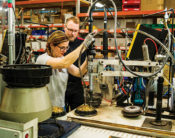Strong leadership at all levels within an organization is essential for achieving organizational excellence. Leaders must not only focus on growing and developing their skills but ensure all members of their teams have the tools necessary to maximize their talent, resulting in a magnetic workplace that fosters employee engagement.
Enterprise Minnesota’s multi-session series Leading for Results will help leaders of small and medium-sized manufacturing companies develop a workplace culture that aligns performance with overall organizational goals while building team competencies.
Under the guidance of Enterprise Minnesota Business Growth Consultants Abbey Hellickson and Michele Neale, the state’s manufacturers can build on the knowledge, skills and abilities they have as leaders to improve retention and develop an overall positive working environment.
Describe the development of Enterprise Minnesota’s new series, Leading for Results.
Abbey Hellickson: Leading for Results complements our Leadership Effectiveness series, formerly called Learning to Lead, which created a foundation for emerging leaders all the way through senior leaders. Now, these leaders can continue to build and grow and strengthen their leadership skills when it comes to their direct reports—the teams of employees they are responsible for leading and managing every day. Leading for Results will really focus on giving leaders that next level of direction and help them maximize results out of the employees they lead.
Michele Neale: After meeting with clients who participated in our Leadership Effectiveness workshops, we discovered there were still gaps, and those who went through the first series of sessions were looking for something more. We took the information from those follow-up conversations, and we started recognizing a theme. So, we decided it would make sense to put together another series that elevates our clients’ needs and focuses on filling those continued gaps.
What will Leading for Results focus on that takes it to that next level?
Hellickson: There is so much to leadership, so we felt like there were more tools to share to help leaders be successful, and we wanted to give leaders a stronger toolset to help them amplify employee performance. A couple of questions that leaders bring up a lot are, “How do I get people to successfully do their job? How do I set those daily priorities? How do I manage that daily work that then aligns to my organization’s overall strategy?” We wanted to give the leaders who are asking these questions a little bit more around that concept. This series will focus on creative problem solving along with maximizing team interactions. When leaders value leading over doing, organizations can meet strategic vision and utilize the full talents of each individual performer.
Neale: Leading for Results will help any leader at any level continue to learn and develop; there is always an opportunity to learn more. There are fundamental skills that are foundational to any leader’s success. It’s about communication, employee engagement, change, accountability. This series takes those topics a little deeper: problem solving for leaders, leadership and the leadership pipeline, managing conflict and developing teams, performance development, and the art of influence and coaching. I think you would be hard-pressed to find a leader who says he or she can’t increase those skills at all. With this series, we can help leaders apply these skills beyond themselves and to their teams. They will focus on behavior changes that they want to see with their teams and shape a workplace culture that improves retention and creates not only individual success but team success and, ultimately, organizational success.
What are the benefits of participating in the Leading for Results program?
Hellickson: Developing leaders at all levels will lead to increased productivity and customer satisfaction; plus, there is the competitive advantage, higher revenues, better margins improvement, and more market opportunities for participating organizations. Leading for Results will also help a company’s leaders improve retention and increase overall leadership skills, which leads to increased productivity and customer satisfaction and develops an overall positive working environment.
Neale: Participants will better understand what transformational leadership looks like and how to communicate and motivate action toward a vision. Because leaders set the tone, motivate, inspire and shape the workplace culture, they will learn how to identify and apply the six laws of problem solving and incorporate problem solving techniques into their methods of developing effective teams and overcoming team dysfunctions.
You mentioned there are five different components the series will focus on. What key takeaways will each session offer?
Hellickson: One session will be about problem solving. When problems arise at work, employees often panic, feel apprehensive about approaching the problem, or pass the problem on to someone else to solve. If an organization has a problem-solving culture, it fosters ideas and activities that extend beyond the problem and encourage innovation. Leaders who demonstrate creative problem solving must also encourage and coach employees to be creative problem solvers as well. Together, they can come up with solutions that lead to long-term success, increased productivity, customer satisfaction, a positive work environment and overall profitability.
A second session will focus on the benefits of leadership and the leadership pipeline. By making leadership development at all levels a priority, positive results in productivity, retention and morale will follow. There are different skills and values required at each level of leadership within an organization, and strong leaders who recognize this can maximize employees’ performance and ensure that work and decisions are done quickly and accurately. Supervisors, managers, team leads, or anyone who directs the work of others will learn how to focus on the right tasks for their level of leadership.
In the session on managing conflict and developing teams, participants will explore the critical role a leader plays in developing effective teams through their ability to successfully manage conflict, coach employees on developing conflict management skills, and develop a culture based on integrity and trust. Team dysfunctions will come up, but there are methods to overcome these. Knowing the conflict resolution techniques and methods that can be applied in a team environment to foster positive communication and workplace relations will directly lead to overall increases in customer satisfaction and profitability. When leaders successfully manage conflict and address issues impacting team performance, teams perform well.
Neale: The performance development session focuses on four key components that include assisting leaders in establishing and communicating goals with employees, defining and assessing good performance, conducting regular performance conversations, and evaluating progress. When organizations focus on developing individual performance that is aligned to organizational strategy and goals, they create for themselves a competitive advantage. These leaders can then cascade those goals through their team and have performance focused discussions to ensure employees are on-track with their own goal attainment that will ultimately benefit the organization and its overall productivity. Giving participants an opportunity to apply what they are learning to real workplace situations will help them reach their goals and ensure their employees reach their goals as well.
The last content-based session, the art of influence and coaching, dives into the true mark of a leader: one who is able to positively influence and coach others. Participants will explore the five components of influence that will assist them in building positive relationships throughout the organization and maximize communication, increase efficiencies, and foster strong work environments. Leaders can also influence through coaching by connecting the organization’s goals to individual goals. Strong leaders use their influence to decrease silos and maximize effectiveness.
What is incorporated into each session that ensures leaders are getting the most out of the series?
Hellickson: There are a lot of different aspects to each session that keep participants engaged and interacting with the material in a meaningful way. From small and large group discussions to case studies and activities and exercises that appeal to different modes of learning, we always make sure that we have highly interactive sessions so participants can easily apply the concepts they are learning to their work environments.
The other main piece we incorporate is called action plans. At the end of every session, participants are asked to identify their key takeaways and choose one thing from the session to implement or try. That might be an application or trying out a model or technique or tactic. Then, when they come back for the next session, the first agenda item is action plan shares. It is an opportunity for them to share what they have been working on from the last session, what worked, what went well, what were the challenges, and they get feedback from the group. It creates an interactive discussion about what is happening in the real world through application of the concepts presented in class. We push the action plans and the action plan shares to really solidify that learning.
Neale: It is so important we end every session with time for them to look at their takeaways and create that action plan. They can really start to make connections between the session content and the changes they want to see in their workplace environments. What are you going to focus on? What is one behavior change you want to see within your team? Then, when we reconvene, there is accountability involved, as Abbey mentioned. What was your action plan and how did it go? What successes did you have? What challenges? What would you do differently? We can hold participants accountable but also not overwhelm them. We encourage them to take one or two items and try it out. Behavior changes are not easy to make. After the content sessions, we have a sixth session, a follow-up session, which is implementation support. We help them pull everything together that we have talked about in the action plan shares and then help them plan another strong action plan for the future. If they want additional coaching or onsite work, we set up a meeting to dig deeper.
What will the schedule for the series look like?
Hellickson: The series includes five content-based sessions and one implementation session (a follow-up session) that Michele was just referring to. The sessions are held semi-weekly and are four hours each. We do a four-week to six-week break between the final session and the follow-up session so participants have enough time to implement the concepts they learned during the series. We will offer Leading for Results in different locations across the state, targeting the same regions where we have had prior success and where we know there is demand and interest. The majority of our sessions will be outstate, Greater Minnesota. We had a lot of success with our Leadership Effectiveness series in Rochester, Owatonna, Mankato, Brainerd, and Alexandria, so we will be targeting those areas again.
Neale: As partners in crime, Abbey and I will split the state. Abbey will primarily lead the sessions in areas south of the Twin Cities, while I will cover the areas north of the Twin Cities. It will be our usual multi-company format, with expected attendance in each location to be around 12 participants and maxing out at 16. Abbey and I developed the series together and are ready to roll it out. We both have sessions launching in January.
How would you summarize the goal or goals of the Leading for Results series?
Hellickson: I think our overall goal is we want to help leaders make their jobs easier. We want leaders to be more comfortable in their role, feel confident in the conversations they are having, and successfully communicate the vision of the organization and connect it with their daily work and daily priorities. Many times, leadership is the foundation for success in other areas. So, that is where we anticipate helping people go. Maybe there is a different focus area that they weren’t ready for prior, but now they have the leadership skills to successfully implement changes and initiatives.
Neale: The names of the sessions reveal a lot; the topics are going to be elevated from previous series we have offered. It’s a deeper dive that will ultimately help leaders and their teams make meaningful behavior changes to better themselves and their employees. It’s truly about leadership development. Are you developing yourself? But more importantly, are you developing others? The goal of this series is to get leaders thinking more about developing others. Organizations get a variety of employees with different social styles, and leaders can better their organization by encouraging and coaching employees in ways they will respond best to.
Once leaders complete the Leading for Results program, what is the next step?
Hellickson: Once the series kicks off and gets further underway, we can analyze how the sessions have been going and see if there are any obvious areas for us to expand on. So, for right now, it is hard to tell what that next step could be. Typically, though, next steps will include a couple of things. First, leaders should really work on the action plans they created throughout the series. There is so much individual growth and development within their organization they can glean from those action plans. Second, based on where they are at, there are options to help support them with continued growth in other areas. It may be outside of the talent area; it may be in continuous improvement; or, maybe it is with a management system. By looking at Enterprise Minnesota’s other puzzle pieces, now that they have the solid foundation, there is an opportunity for leaders to think about other areas of their business that they want to improve or grow.
Neale: Leaders in manufacturing, naturally, are destined to focus on process and production. That is just in their DNA. So, sometimes they forget about the people component. If you don’t have people, what are you left with? The Leading for Results series will help manufacturers become knowledgeable, in-house leaders so that once the series is completed, they can continue working on changing how they engage with their workforce. With the workforce the way it is, it is important they continue asking themselves, “Are you investing in your people?” People are their biggest asset.
…
Featured story in the Winter 2019 issue of Enterprise Minnesota magazine.


